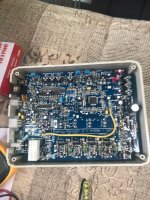This reply may be far too late for the ordinal poster but may be useful for people finding this post at a later date.
Our Motorhome has the Kigass System installed and you are right that the Company that manufactured these parts went under back in about 2007. There are no spares and no support for these products and zero technical information has been made available !
I have had to pull my Kigass System apart on several occasions so I have quite good knowledge of its inner workings !!
Our Kigass System uses the earlier series 1 Energy Manager which is quite different to the series 2 controller shown in the photo in the earlier post so I can’t confirm if the leisure batteries are connected in the same way. All I can say is the system does provide the voltage data for each
battery so this would be difficult if the two
battery connections are just shorted internally.
The Kigass Energy Manager series 1 has two separate inputs for the two supported Leisure Batteries. There is also an input for the Starter
Battery. Each
battery has its own controller and you should not parallel up the connected batteries.
Some of the Kigass Energy Managers series 1 also have an input for a
Solar Panel. I would not use this input as it is limited to about 80 Watts. Our System had a 100W panel connected and it burnt out the controller board one sunny day !!!!!
So adding
Solar to one of these controllers is not really recommended. If you are so unlucky to have this Kigass System fitted to your Motorhome you may need to consider wiring in a more modern Management System and getting shot of the Kigass System. The Kigass System also only support the older Lead Acid Wet Batteries so be very wary of using more recent
battery technologies if you have one of these Kigass Systems.
James
Devon

